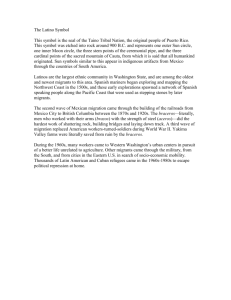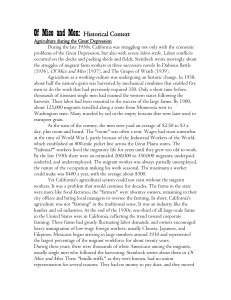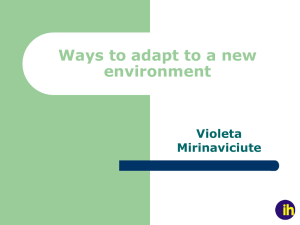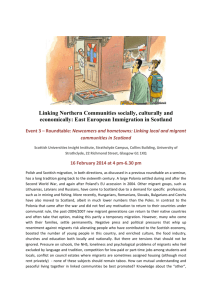Theme 2: Who are migrants?
advertisement
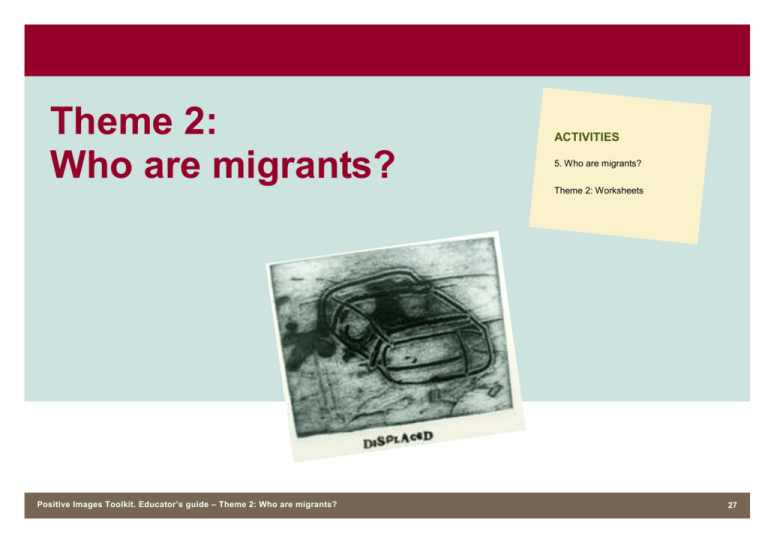
Theme 2: Who are migrants? ACTIVITIES 5. Who are migrants? Theme 2: Worksheets Positive Images Toolkit. Educator’s guide – Theme 2: Who are migrants? 27 Activity 5. Who are migrants? Aims (PowerPoint slide 1) To understand the meaning of the terms refugee, asylum seeker and migrant worker. To learn more about who migrants are. Total Timing One hour and ten minutes, or one hour and 30 minutes with the extension activity Timing Activity Understanding migrant terms 10 minutes Educator tip You could start with the starter activity from activity 1, if students are not familiar with the terms migration and migrants. Handout one copy of worksheet 11 to each student. Ask students to match the terms to the definitions. Materials Worksheet 11: Migrant definitions (one copy per student) PowerPoint slide 2: Migrant terms As a group go through the correct definitions for each term. The correct matches are: 1b, 2c and 3a (PowerPoint slide 2). As a group discuss the following (PowerPoint slide 3): Have you heard these terms before? What do you know about these? Where have you seen these terms used? PowerPoint slide 3: Migrant term questions Explain that as sometimes people who migrate have less protection when they are outside their home country, there are special international laws protecting migrants. ‘Refugee’ and ‘migrant worker’ are terms that describe someone’s legal situation when they are outside their home country. Film 1: Why do people migrate? 10 minutes Inform students that they will watch a short film where people explain why they migrated. Hand out a copy of worksheet 12 to each student. Ask students while watching the film to complete the ‘reasons for migrating’ and ‘legal situation’ part of the worksheet for each person. Watch film 1. Alternatively you can ask one of the students to read out the film 1 transcript, worksheet 2. Educator tip If you have already watched film 1 with the students, simple ask students to use their answers from worksheet 1. They can then complete the ‘legal situation’ part for this activity. Positive Images Toolkit. Educator’s guide – Theme 2: Who are migrants? Worksheet 12: Film exercise, one copy per student Film 1: Why do people migrate? or worksheet 2: Film 1 transcript 28 Activity 5. Who are migrants? Timing Activity Film 2: Who are migrants? 10 minutes Now tell students that they will watch a second film. The people in the film describe their legal situation. Materials Film 2: Who are migrants or worksheet 13: film 2 transcript Ask students while watching the film to check if the legal situation they wrote in the previous activity was correct. Watch film 2. Alternatively you can ask a student to read out stories from film 2, worksheet 13. Check the answers as a group. The correct answers are: Sajwaa is a refugee, Shakeeb is a migrant worker, Ines is a migrant worker, Priyanga is a refugee, Glenda is a migrant worker and Ebrahim is an asylum seeker. Creating a profile 30 minutes Place students into groups and tell them that they will create a profile of one of the people from the two films. One large sheet of paper per group, for students to draw a person’s outline Ask students to complete the following (PowerPoint slide 4): Draw an outline of your chosen person on a large piece of paper. Illustrate who the person is. On the inside of the profile, write or draw what the person might be feeling or thinking about their situation. On the outside write or draw about the situation the person faces in the outside world, in their home country and in their new country. For example think about the things that made the person leave their country and their current legal situation. Pencils and pens PowerPoint slide 4: Creating a profile activity instructions Encourage students to illustrate both positive and negative things. Student can refer to the film transcripts (worksheets 2 and 13). They can also use the words on PowerPoint slide 5, which are from the films for inspiration. Worksheets 2 and 13, one per group Finally ask students to stick their profiles on the wall around the class and share these with other students. PowerPoint slide 5: Words Positive Images Toolkit. Educator’s guide – Theme 2: Who are migrants? 29 Activity 5. Who are migrants? Timing Activity Review questions (PowerPoint slide 6): 5 minutes How can we define a refugee, an asylum seeker and a migrant worker? What do these terms mean? Why are they important? Did you learn anything new about who migrants are? Share this with the group. Extension activity: A poem Read the poem by Wondimu Mekonnen with the group (worksheet 14). 20 minutes Ask students to discuss the following questions (PowerPoint slide 7): What does the author think about who he is? How does he feel he is seen by others? How does he feel that being an asylum seeker affects his identity? What thoughts and feelings does the author express? Have you ever felt that way? When did you feel this way? How does this poem help you to understand what it might feel like to be a migrant? Homework activity: Migrant laws Homework activity Refer to worksheet 15, which includes an activity on researching international laws protecting migrants. Materials PowerPoint slide 6: Review questions Worksheet 14: A poem by Wondimu Mekonnen PowerPoint slide 7: Poem questions Worksheet 15: Migrant laws Take action on migration! Place students in groups and hand out worksheet 16. Encourage students to work in groups to build on their learning by taking action. Positive Images Toolkit. Educator’s guide – Theme 2: Who are migrants? 30 Worksheet 11: Migrant definitions Activity 5: Who are migrants? Match each term to the correct definition Term Definition Refugee a. A person who is in paid employment in a country where they are not a national. Asylum seeker b. A person who has left their home country because they are afraid of being persecuted or badly treated because of their race, religion, nationality, because they belong to a particular social group, or because of their political opinion. As a result they cannot seek protection from their home country. Migrant worker c. A person who has left their country and has applied for recognition as a refugee in another country, and is awaiting a decision on their application. Positive Images Toolkit. Educator’s guide – Theme 2: Who are migrants? Disclaimer: The definitions have been simplified for a young audience and are not intended as a reflection of the exact legal terms 31 Worksheet 12: Film 2 exercise Activity 5: Who are migrants? While watching the film, use this worksheet to: Note down the reason each person in the film gives for migrating Note any new words Name Reasons for migrating Name Sajwaa Ines Shakeeb Priyanga Alain Glenda Ebrahim Reasons for migrating To find a better job and to support her family Left home because of persecution New words Positive Images Toolkit. Educator’s guide – Theme 2: Who are migrants? 32 Worksheet 13: Film 2 transcript Who are migrants? Activity 5: Who are migrants? (Glenda) “I’m not an asylum seeker, I’m a migrant worker, I came here for work legally”. (Sajwaa) “I’m not an economic migrant, I’m a refugee. The government has agreed to let me stay legally in the country because I was persecuted in my country”. (Ebrahim) “I’m not a refugee but I’m an asylum seeker which means the government hasn’t decided whether to accept me as a refugee or not”. (Priyanga) “I’m a refugee”. Positive Images Toolkit. Educator’s guide – Theme 2: Who are migrants? (Shakeeb) “I’m a migrant worker”. “An asylum seeker is just a status, but beyond an asylum seeker there’s a person”. (Glenda) “I’m a nurse, I’m a Filipino, I’m a hard worker, and I am very good and very friendly”. (Sajwaa) “I’m a teacher, I’m a mother of three. All three of my children study, and I am your neighbour”. (Ines) “I am a woman. Like every woman in the world I am a daughter, a sister, a mother, worker. I’m resilient, I’m passionate and I smile when I’m nervous!” 33 Worksheet 14: A poem by Wondimu Mekonnen Activity 5: Who are migrants? I am an asylum seeker, On the run from bondage; Unwelcome ‘trouble maker’, Undesirable package. In the homeland a rebellion, In the host-land a nuisance; Gone down to my oblivion, Hanging out in suspense. I am an illegal entity, Nobody cares to know; Stripped of liberty, Pushed aside taboo low; Wasted talent lost wisdom, Barred by an invisible wall, Restricted freedom Dehumanised soul In an asylum seeker’s Ghetto, Facing up the reality, Surviving incognito; Concealing my identity. Positive Images Toolkit. Educator’s guide – Theme 2: Who are migrants? 34 Worksheet 15: Migrant laws Activity 5: Who are migrants? Select one of the two laws below that seek to protect migrants. Research this law, answering the questions below. Present your findings to the rest of the group. 1951 Geneva Convention on Refugees www.unhcr.org International Convention on the Protection of the Rights of All Migrant Workers and Members of Their Families www.ohchr.org Positive Images Toolkit. Educator’s guide – Theme 2: Who are migrants? Questions What does this law say about protecting migrants? How is this law being applied in practice? What is the effect of this law on people who migrate and their communities? What else could be done to protect people who migrate? 35 Worksheet 16: Take action on migration! Take action! Inspire me! Celebrate World Refugee Day and International Creative print making Migrants Day. The United Nations has What did they do? designated special days each year to celebrate and raise awareness of global issues. UN World Refugee Day is on 20 June each year and International Migrants Day on 11 December each year. Get involved in community events to celebrate and raise awareness of the unique experiences and contributions of refugees and A youth group invited a young person who was an asylum seeker to share her story with them of seeking refuge and the truth of the hardships she faced. The young people then, supported by a local artist, used print making techniques to illustrate what they learnt from the story. Young people based the images they created on a one word response to their new understanding of seeking asylum. migrants to your community. The images were displayed in a touring exhibition of local libraries in the surrounding area. Useful links: www.un.org/en/events/refugeeday/ www.un.org/en/events/migrantsday/ What did the artist say? Arrange for a migrant or a charity supporting migrants to deliver a talk in your school or youth group. Contact a local charity in your area supporting people who have migrated and ask “This project has given young people the valuable opportunity to expand their understanding of what it is really like to seek asylum and why some people need refuge. This work has enabled the young people to formulate and express their views on what is a complex topic from a standpoint of accurate knowledge”, (artist Tim Smith). them to deliver a talk and share stories, to help raise awareness of migration. Positive Images Toolkit. Educator’s guide – Theme 2: Who are migrants? 36 Worksheet 16: Take action on migration! Take action! Inspire me! Local action, global issue Fashion parade What did they do? What did they do? A youth group created costumes with a 1950s theme, reflecting the date that the 1951 Refugee Convention was created. >A group of young people worked together to create a short message and an image promoting acceptance and understanding towards migrants. The clothes used fabrics from different countries and reflected key messages from the Refugee Convention. They uploaded the message and image to their Face book profile and sent it to their friends on International Migrants Day on 18 December. It reached 10,000 people! They performed a fashion show parade in central London to celebrate World Refugee Day. What did the artist say? “I spread a message of tolerance towards migrants through Face book to let young people know about our campaign” (young volunteer). Positive Images Toolkit. Educator’s guide – Theme 2: Who are migrants? 37
